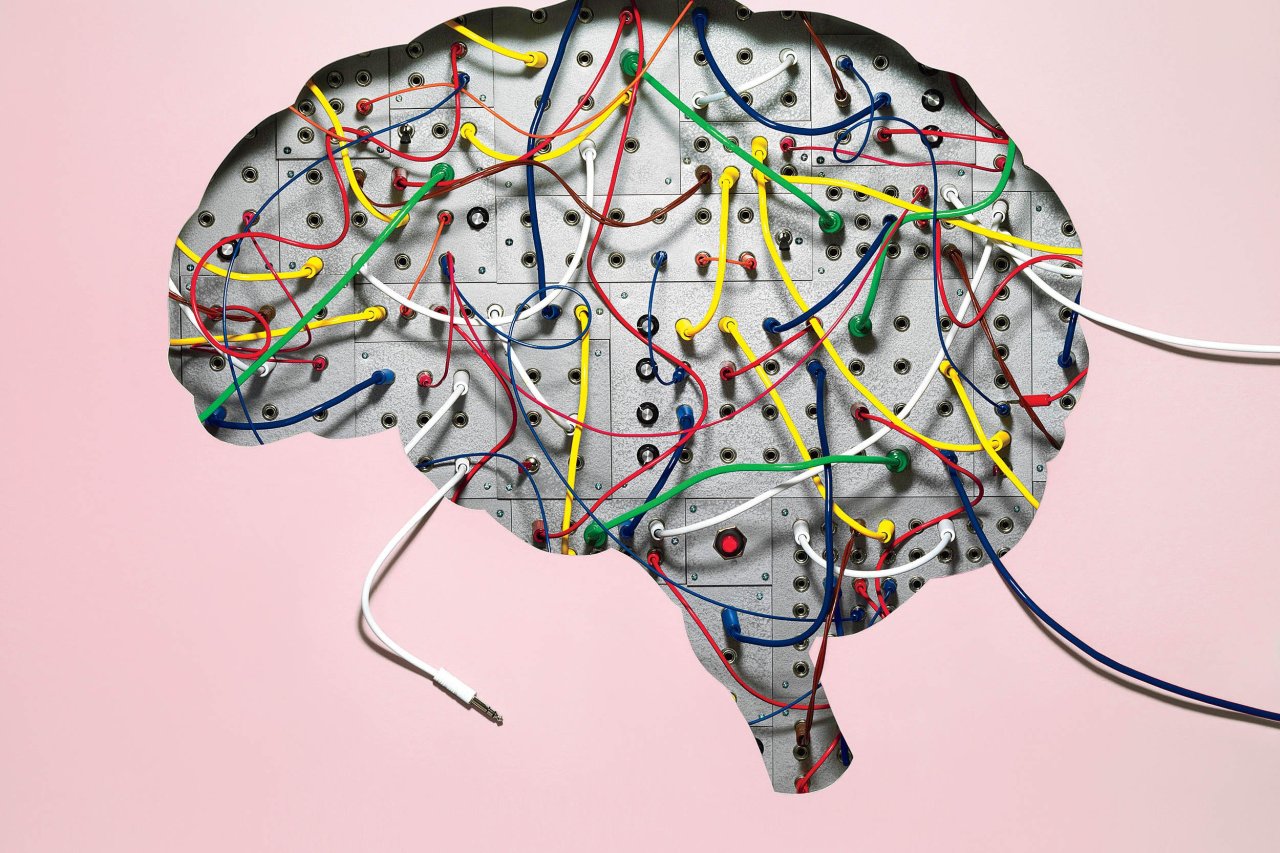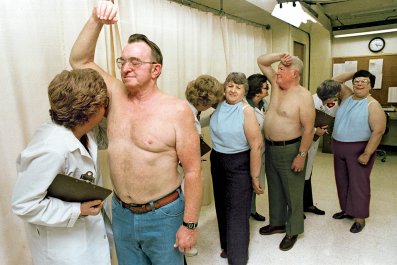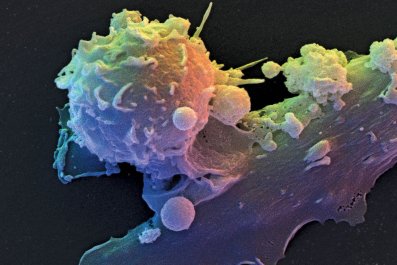Richard M. Cohen leans forward as the needle plunges into his back. He kvetches as its tip pushes toward his spinal column, though it is a good-natured plaint. He has, after all, been through this before. We are on the far West Side of Manhattan, 57th Street, with the dusky Palisades of New Jersey looming on the far bank of the Hudson River. Right across the street are the studios of CBS, where Cohen, a television reporter and producer, came to work for the legendary Walter Cronkite in 1979 and then for Dan Rather, who replaced Cronkite two years later.
Cohen went everywhere back in those bygone days when journalists still went to wherever the world was exploding. He reported from Poland in 1981 about the rise of the Solidarity movement, then from Beirut during the Israeli invasion of Lebanon in 1982, then from the conflict in El Salvador. The entire time, he harbored a secret: He had multiple sclerosis, a degenerative neurological disease that afflicts 400,000 Americans and which Cohen calls "a grim pileup on the highways of the central nervous system," an erosion of the insulating fat, called myelin, that surrounds the nerves. Once those myelin sheaths wear away, the nerves can no longer properly conduct electrical signals, leading to a host of neurological and physical symptoms. Cohen's walking, for example, eventually became so unsteady that people assumed he was drunk.
Cohen was diagnosed when he was 25. He was living in Washington, D.C., working on a PBS documentary on disability. He was making coffee for his newsroom colleagues when the pot slipped from his hands, crashing to the floor. He thought nothing of it, but then, later that day, he lost his balance and lurched forward into the street. Shaken, he went home to have a beer. As he sat down on the couch, he felt a strange numbness in his leg. "I think you have multiple sclerosis," Cohen's father, a physician, said upon hearing his son's symptoms. He had it himself, after all. So did Cohen's paternal grandmother.
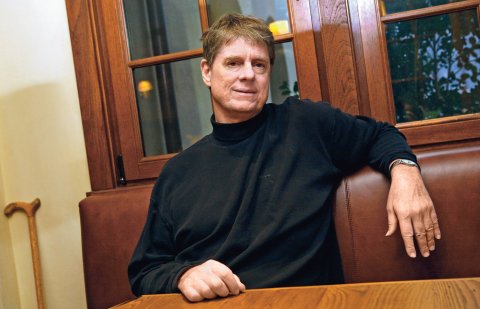
"The diagnosis came with a perfunctory phone call," Cohen wrote in The New York Times in 2000 of the day in 1973 when he definitively learned he had MS. "There was no mention of treatment, no helpful advice. I could feel the neurologist's shrug through the wire. I sat alone and in silence. I was only 25, and did not know what to do. No neurologist I've come across has much to offer, beyond a few new drugs. I reach out, but with nothing to touch." Like all those who receive the diagnosis, Cohen had to confront the bleak reality that his brain would eventually give out on him.
Today, Cohen is 66 and retired. His hair is still thick, but it is now fully gray. He walks with a cane, and there is a tremor in his voice. A stud in his left earlobe alludes to a younger self, a self who is aware of the disease festering in his brain but not yet cowed by it. Perhaps worst of all, for a man whose life has been lived in images, he can barely see: The memoir he wrote in 2004 is calledBlindsided.
Though we met across from the CBS studios where he made his career, Cohen did not choose the location out of nostalgia. We were at the Tisch MS Research Center of New York, where Cohen is one of the first 20 or so patients to be enrolled in a stem cell therapy treatment pioneered by Dr. Saud A. Sadiq, whom Cohen had met at a conference. The therapy, still in the early stages, harvests stem cells from subjects' bone marrow and transforms them in a laboratory into "neural progenitors." Injected into the patient's spinal fluid, the neural progenitors could eventually lead to the repair of the myelin sheaths in the brain, an organ Cohen calls in his book "that exotic place just north of the neck."
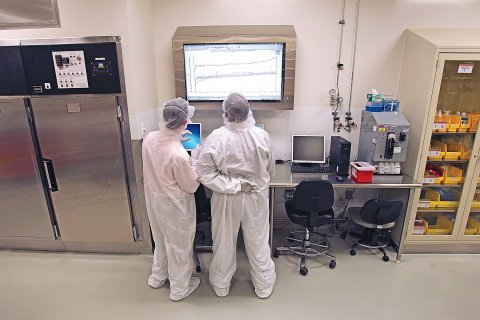
Cohen has been chronicling his struggle with MS on a blog called Journeyman. There, he wrote of his first treatment from Sadiq, which was so uncomfortable he joked about it being "in violation of the Geneva Conventions." Despite the discomfort, the trial appears to be safe. Whether it is effective remains unknown: One critic, Dr. Sally Temple of the Neural Stem Cell Institute, has said that it "is unlikely that these cells will replenish lost neural cells," because harvested neural progenitors aren't exactly like those native to the body. But after four decades of fighting his own brain, Cohen is willing to take chances, even those that involve long dates with long syringes.
Sadiq's effort is part of a broader push to understand neurological disorders that affect the structure of the brain. As the baby boomers pass into senescence, more and more of that generation's members will be felled by disorders like MS, Alzheimer's (which affects 5 million Americans) and Parkinson's (1 million). "Neurological disorders are going to be a rising tide of trouble," says Dr. Dennis J. Selkoe, co-director of the Center for Neurologic Diseases at Brigham and Women's Hospital in Boston.
Selkoe is the co-director of the Ann Romney Center for Neurologic Diseases, which the former first lady of Massachusetts intends to seed with $50 million in donations, including a reported "substantial gift" from herself and husband Mitt. Romney was diagnosed with MS in the late 1990s, and the center's co-director will be her longtime neurologist, Dr. Howard L. Weiner of Brigham and Women's. And to underscore the fact that brain disease knows no political distinction, the center's board will reportedly include both true-blue Democrats, like Massachusetts congressman Joseph P. Kennedy III and Chelsea Clinton spouse Marc Mezvinsky, and high-profile Republicans like Mitt Romney and Fox News host and MS sufferer Neil Cavuto. Also on the board will be Richard Cohen's wife, NBC talk show host Meredith Vieira.
And the push for a cure is folded within a greater mission to understand the brain, a task the White House has deemed one of its "grand challenges," allocating some $100 million in federal research funds to that effort. The quest has been a long time coming. Selkoe explains that, for many years, a sort of "therapeutic nihilism" afflicted the study of the brain, a helplessness stemming from a lack of knowledge. That, in turn, scared off researchers. "There was only one guy in my medical school class who went into neurology," he recalls. "And that was me."
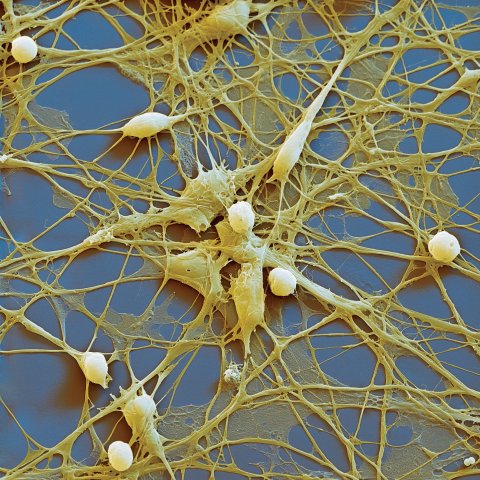
There's a Thief in the House
In 1868, French pathologist Jean-Martin Charcot described "la sclérose en plaques," a buildup of lesions caused by injury to the myelin sheaths, the resulting damage to the nerve filaments (called axons) underneath and the scars that form in response. Though others had spotted the effects of MS on the brain, Charcot—often called the father of neurology—was the first to fully understand MS as its own disease (he also discovered amyotrophic lateral sclerosis, or ALS, better known as Lou Gehrig's disease).
We have learned plenty about MS in the 150 years since. We know, according to Selkoe, that it is "the quintessential autoimmune disorder," one in which white blood cells (T lymphocytes, to be exact) cross the usually impermeable blood-brain barrier, eating away at the fatty myelin covering the nerves and thus leading to barren patches that, on a brain scan, are the telltale sign of the disease. We know MS does not have overly high heritability; we do know that there is a genetic component, rooted principally in a family of immune genes called the major histocompatibility complex, though dozens of other genes may have their say. Environment plays a role, too, with a lack of vitamin D seen as a risk factor: MS is more likely to afflict people who live far from the Equator. Smokers are at greater risk too, as are people who've had infectious mononucleosis, or mono.
While the mechanism of some brain disorders—autism, for example—remains poorly understood, we at least know some of what multiple sclerosis does and how it does it. Problem is, that hasn't made it any easier to halt the ravages of the disease, at least in part because most MS lesions produce no symptoms. By the time a person is diagnosed, plenty of damage has already been done, the brain riddled with lesions. We come to realize that a thief has plundered the house, but that chilling knowledge won't hamper his sure return.
The neurologist, then, plays the part of the overmatched but relentless detective, looking desperately for clues. "If MS is an immune disease, then you should be able to have an immune marker," says Weiner, one of the nation's leading authorities on the disorder. He has called finding a biomarker that could be discerned by a simple blood test "one of the next major frontiers" in MS research.

Awareness of MS often comes slowly, especially since the vast majority of patients have the relapsing-remitting form of the disorder, which waxes and wanes. (About 10 percent have the more severe primary progressive form of MS, in which there are no such periods of retreat.) The first symptoms may be hardly noticeable: numbness in the limbs, a tingling down the spine when the head is bent forward (a sensation that has its own name in neurology: Lhermitte's sign). But there are no lumps, no bleeding, and one may have plenty of time before the disease strikes again, though strike again it certainly will. In Blindsided, Cohen acknowledges that because MS is a chronic, nonfatal condition, it "occupies a lowly position in the hierarchy of suffering."
The disorder will usually advance haltingly, covertly, slipping past even the hypochondriac who studies the shape of every mole but may think nothing much of the seemingly innocuous tingling in his right arm. That's an unfortunate aspect of the disorder: Dr. Mark S. Freedman, a neurologist at the University of Ottawa, has found that early intervention could have a significant effect in shaping the outcome of MS treatment.
Weiner's team has identified potential biomarkers that could signal the presence of MS, with circulating MicroRNA as one promising agent. A researcher at the University of Geneva, Dr. Cindy Salvisberg, has discovered that MS patients have an elevated level of a protein called serpin A3 in their tears. But until large-scale testing confirms either these or others as viable biomarkers, it will take the dropped coffee mug or persistently numb leg for the realization to dawn that something serious is amiss.
Stripped Bare
The breakthrough everyone's after is the one that will heal the brain, not just seal it off from future attacks. The first true therapy for MS appeared in 1993: betaseron, which belongs to a class of drugs called interferons, compounds that disrupt the way rogue T lymphocytes communicate with each other and help keep them from crossing the blood-brain barrier. They are able to slow the progress of MS and perhaps lessen the severity of symptoms. They cannot, however, erase extant ravages. "None of the therapies are restorative or reparative," explains Dr. Rohit Bakshi, a neurologist at Brigham and Women's.
I met Dr. Ari J. Green of the University of California at San Francisco (UCSF), at the medical school's gleaming new campus in the city's Mission Bay neighborhood. Green, an ebullient young South African expatriate, calls himself "Weiner's grandson"—his mentor at UCSF is Dr. Stephen L. Hauser, who was in turn mentored by Weiner. The world of MS research may be bigger than it once was, but it's still not that big.
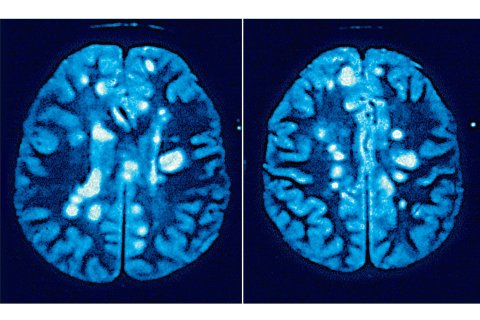
Green isn't just trying to stop the disease; he is trying to reverse it. He and a colleague at UCSF, Jonah R. Chan, along with several other collaborators, are trying to find a way to stimulate cells called oligodendrocytes, which make myelin, to repair the axons stripped bare by MS. Instead of injecting stem cells, like Sadiq in New York, they are trying to galvanize the body to do the work itself. In August, Green, Chan and their colleagues published a paper in Nature Medicine called "Micropillar arrays as a high-throughput screening platform for therapeutics in multiple sclerosis."
The title is daunting, but the premise is simple. A culture dish is dotted with synthetic glass pyramids that act the part of an unsheathed nerve. In a sort of forced prom dance, the pyramids are paired with oligodendrocytes. Then comes the potentially magic potion. Green and Chan wanted to see which compounds could stimulate the oligodendrocytes to wrap myelin around the pyramids. They applied 1,000 different molecules to the plates, then measured the thickness of the myelin rings. They discovered that no compound was as effective as an over-the-counter antihistamine called clemastine. The same medicine you take to treat a runny nose during the spring allergy season might also play a crucial role in regenerating the brain.
Of course, plenty of study remains: Clemastine may be safe for human use, but that doesn't make it an effective MS therapy. Nevertheless, Green is optimistic, and expects initial results by the spring. He also admitted to some challenges. While Green believes his method is more sophisticated than Sadiq's, he does not know whether in vitro results can be replicated in human subjects.
Others are working to halt MS that is no longer in the intermittent relapsing-remitting stage but has entered a progressive stage in which the brain's degeneration continues at a steady clip. There's "very little we can do about progressive MS," explains Lior Mayo, a young Israeli neurologist who joined Weiner's lab five years ago. He is working on a nasal vaccine, which is intended to enhance the immune system's ability to regulate itself. If his research holds up, there would be no needles, no lengthy infusions, just a quick spray into the rich mucosal lining of the nose. From there, the antibodies would travel to the immune system, where they would forfend attacks on the central nervous system.
Like most of the other researchers I spoke to, Mayo is both deeply hopeful and thoroughly uncertain. The brain, after all, does not easily give up its secrets.

Diagnose and Adios
When the Olympic flame arrived at Salt Lake City for the Winter Games in 2002, it was carried in part by Ann Romney, whose husband Mitt was then heading the city's committee for the event. Romney did not carry the torch for long: a fifth of a mile, perhaps. But it was momentous journey nevertheless, because four years earlier, she had been diagnosed with the remitting-relapsing form of MS. "We were looking at, potentially, us seeing a wheelchair in her future," her husband told CNN in the summer of 2012, as the Olympics in London were about to start.
The brief run with the flame in Salt Lake City signaled a turning point in her fight. "That was when I knew I was going to be OK," Ann Romney told me, shortly after she announced the pledge to raise $50 million for the Romney center.
Romney says she was a "pretty athletic, pretty healthy person," an accomplished equestrian who raised five sons. Her first symptom was a common and seemingly innocuous one: a numbness in her right leg. She thought it was a pinched nerve. But then other symptoms appeared: loss of balance, fatigue. She described these to her brother James A. Davies, who is an ophthalmologist. His advice was ominous: "You need to call a neurologist."
Romney went to a major Boston hospital, where "the diagnosis was clear." But despite that, there was little sense of urgency. "A pat on the head, and call us when it gets really bad," she remembers, incredulously, of the treatment she got there. "That was it." (In Blindsided, Cohen calls that approach "diagnose and adios.")
"I remember thinking my life was 100 percent over," Romney says. On a friend's advice, she went to see Weiner two months after her initial diagnosis. He immediately put her on a steroid treatment, and though he was able to stop the progression of the disease, he could do nothing about the lesions already blemishing her brain. Romney says that for the next four or five years, she was "hanging on there by a thread," and even though the progression of her MS has been halted, she says "there's always a Charlie Brown black cloud" looming over her.
On the day I spoke to Romney, a niece to whom she had been close passed away from complications relating to Alzheimer's, a disorder that in many ways remains less understood than MS. In addition to those two ailments, the Romney center will focus on ALS, Parkinson's and brain tumors, which have more in common with neurological diseases than with other cancers.
"There are gonna be some breakthroughs in the next decade," Romney told me. "I really believe that."
Romney has been lucky, with some of the finest medical care in the nation keeping her MS at bay. But the disorder has plenty of other prey. Others are now feeling the first tremors of multiple sclerosis, the initial numbness, the suspicious tinge. They, too, will need someone to help them run again.



